Journal
of Non-lethal Combatives, Feb 2001
The Secrets of Jujitsu, A Complete Course in Self
Defense, Book VI

By Captain Allan Corstorphin Smith, U.S.A.
Winner of the Black Belt, Japan, 1916. Instructor of Hand-to-Hand Fighting,
THE INFANTRY SCHOOL, Camp Benning, Columbus, Georgia and at United States
Training Camps and Cantonments, 1917 and 1918.
In Seven Books.
BOOK SIX
STAHARA PUBLISHING COMPANY
Columbus, Georgia, 1920.

***
This electronic version is copyright EJMAS © 2001. All rights
reserved.
Contributed by Thomas J. Militello, a 15-year member of Astoria,
New York's non-profit Horangi Taekwondo Dojang, which is headed by James
Robison.
The class of tricks taught in Book Six is very effective, but do not
make the mistake of thinking that all you have to do is merely to go and
seize anyone, even the most burly opponent, to reduce him to a quivering
heap of helpless humanity.
Tricks like the Wrist Twist are best done after an Assailant has actually
got hold of you. See Book Five.
They are not so practicable when an Assailant is apparently going to
strike you. The proper defenses for such cases have previously been taught
in this course.
The "Reverse Wrist Twist" shown below depends for its success upon the
way you twist his wrist by the weight of your body in moving from the position
of Figure 170 to that of Figure 171. The same remarks apply when you try
it on a man who has seized your hair. See Figure 173.
By practicing these four Wrist Twist Tricks you will gradually discover
how to use your body to offset the strength in the hands of a more powerful
man.
Lesson 31. Wrist Twist when throat is seized.
Lesson 32. Wrist Twist when coat is seized.
Lesson 33. Reverse Wrist Twist when throat is seized.
Lesson 34. Reverse Wrist Twist when Hair is seized.
| |
Name of Partner |
Date Commenced |
Lesson 31 |
Lesson 32 |
Lesson 33 |
Lesson 34 |
| 1. |
|
|
|
|
|
|
| 2. |
|
|
|
|
|
|
| 3. |
|
|
|
|
|
|
| 4. |
|
|
|
|
|
|
| 5. |
|
|
|
|
|
|
| 6. |
|
|
|
|
|
|
| 7. |
|
|
|
|
|
|
| 8. |
|
|
|
|
|
|
| 9. |
|
|
|
|
|
|
| 10. |
|
|
|
|
|
|
Lesson 35. The Hammerlock.
Lesson 36. The Hammerlock with one hand. On two men.
Lesson 37. Escape from Hammerlock.
Lesson 38. A swift method of making an arrest.
| |
Name of Partner |
Date Commenced |
Lesson 35 |
Lesson 36 |
Lesson 37 |
Lesson 38 |
| 1. |
|
|
|
|
|
|
| 2. |
|
|
|
|
|
|
| 3. |
|
|
|
|
|
|
| 4. |
|
|
|
|
|
|
| 5. |
|
|
|
|
|
|
| 6. |
|
|
|
|
|
|
| 7. |
|
|
|
|
|
|
| 8. |
|
|
|
|
|
|
| 9. |
|
|
|
|
|
|
| 10. |
|
|
|
|
|
|
Make a check mark against each trick each day you practice it.
WRIST TWIST WHEN THROAT IS SEIZED
Assailant seizes your throat.
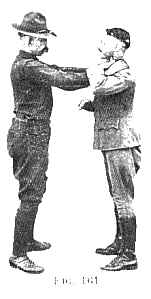
Bring your left thumb onto the back of his right hand and your fingers
around the root of his thumb. (If Assailant’s hand is stronger than yours,
you cannot secure the wrist twist by hand strength. You must unbalance
Assailant to the point where his hand exerts only 20% of its power. Experiment
and study the figures.)
Hold his right hand tightly against your body and step back with your
left foot, thus pulling him off balance.
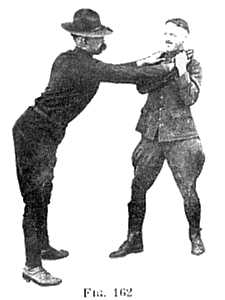
Bring your right thumb onto the back of his hand and your right fingers
onto his palm.
Twist his wrist, bringing him into the position of Figure 163.
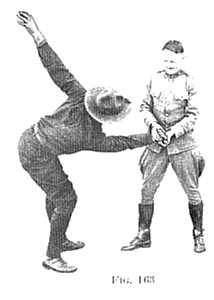
Keep him off balance all the time you are twisting. Make him
give the signal of defeat.
It is easy to force opponent onto his back by the pressure on his wrist.
It is unnecessary to trip him. In this position you can easily hold him
prisoner as long as you choose.
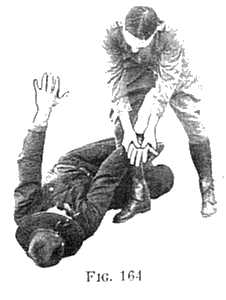
If the circumstances call for it, you may disable him by breaking his
wrist.
WRIST TWIST USED ON MAN WHO SEIZES YOUR COAT
Assailant seizes the right side of your coat with his left hand.
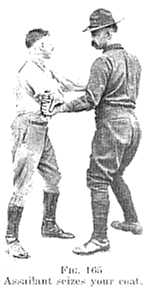
Place your right hand on the top of his left hand, fingers up on his
palm, and your thumb on the back of his hand with the correct wrist grip.
Hold his hand firmly against your side. Step back with the right foot
so that you pull him off balance and twist his wrist slightly.
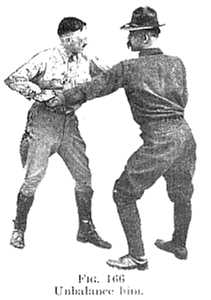
By holding his hand firmly against your body you will more easily be
able to twist his wrist.
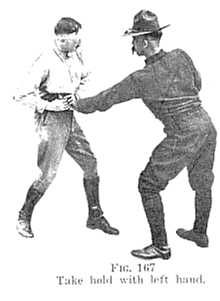
Bring the thumb of your left hand onto the back of his right and your
fingers onto his palm.
Twist his wrist slowly into position of Figure 168, keeping him off
balance all the time, and make him give the signal of defeat.
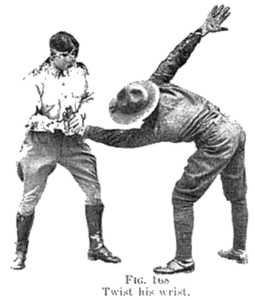
THE REVERSE WRIST TWIST WHEN THROAT IS SEIZED
Assailant seizes you by the throat.
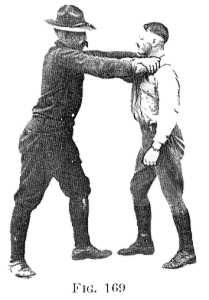
Bring your right hand up beneath his left arm. Place the root of your
right thumb on the back of his right hand, and your fingers round the little-finger
edge of his hand, grasping the palm.
Hold his hand tightly to your body and step back with your left foot,
thus pulling him off balance.
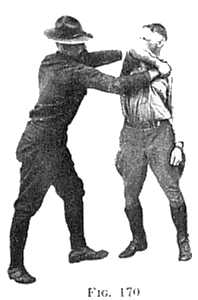
Step back with your right foot, swinging your left shoulder forward,
twisting his hand by the weight of your body.
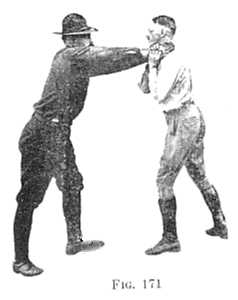
Bring the root of your left thumb onto the back of his right hand and
the left fingers onto his palm.
Step back, pulling him off balance.
Press his palm directly towards him, exerting all your pressure on the
back of his hand. You can easily disable him by breaking his wrist.
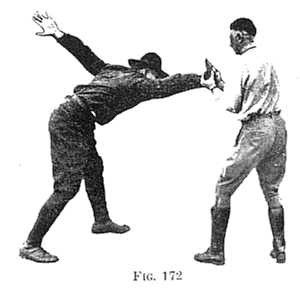
In practice do it slowly and release him the instant he quits.
REVERSE WRIST TWIST WHEN YOUR HAIR IS SEIZED
Assailant seizes your hair with his right hand.
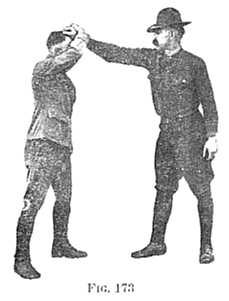
Place your right hand on the back of his hand with your little fingers
encircling the little finger edge to his palm. Do not try to pull his hand
off. Press it firmly down onto your head.
Step back with your right foot, bending your head away, forward and
to your right. Keep pressing his hand tightly down on your head. Pull him
forward off balance until his hand loses its power.
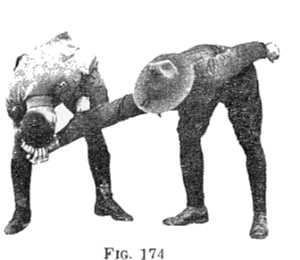
With the root of your right thumb, press the back of his hand towards
him. Step farther back, pulling him more off balance. Bring palm
of your left hand onto the back of his right, with your fingers around
the root of his thumb. This will make him let go.
Press the palm of his hand directly towards him and rise to position
of Figure 175.
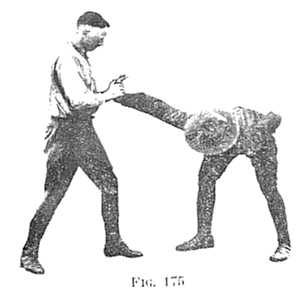
In making him give the signal of defeat, be careful to do it slowly,
otherwise you may injure him.
WRONG METHOD
Carefully study Figure 176, where I have bent forward, instead of swinging
to my right.
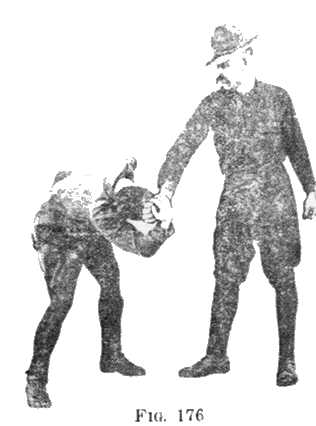
My Assailant is on balance. His hand is gripping my hair with
100% of its strength and I am unable to pull it off.
If your practice of this trick has not been successful, you will find
that you have been omitting to unbalance your Assailant.
Assailant at first should not grip the hair, but simply lay his hand
on opponent’s head until the trick is mastered.
THE HAMMERLOCK STANDING
When a man stands naturally, the backs of his hands are slightly towards
the front.
Lay your right palm on the back of his right hand, your thumb round
the root of his thumb and your fingers around the little-finger side of
his hand. Pass your left hand outside his arm and place it behind and above
his elbow.
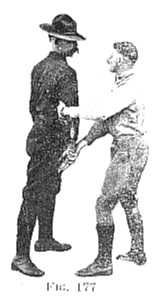
Pull his elbow outwards, and towards you. Press his hand straight behind
him, stepping forward so that your chest comes against his upper arm. Keep
his arm in that position by the weight of your body.
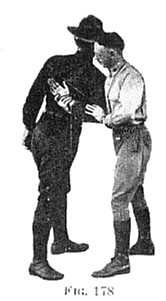
Slip your left hand to his wrist and your right hand to his elbow. As
you do this, step behind him. Press his elbow in, toward the small of
his back. Press his hand directly toward his right shoulder.
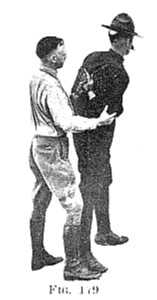
Keep your strength and balance in your Stahara. Force him onto his tiptoes
and you can march him where you will.
This is a valuable hold for policemen, and I will make a suggestion
about their practice. Big strong men are apt to do tricks such as this
by sheer strength. If, instead, you will do a certain amount of practice
without using your strength, you will become more scientific. You will
discover the lines of least resistance. You will find out how to unbalance
your man. As a result you will be able to use your strength more effectively.
Tricks like this depend upon the element of surprise for success and
cannot be done in a jujitsu match where each opponent is on guard.
TO MARCH A PRISONER WITH ONE HAND
Secure Hammerlock first. Then, slip your left forearm between his right
forearm and his back until your elbow is below his right wrist and your
hand on his upper arm.
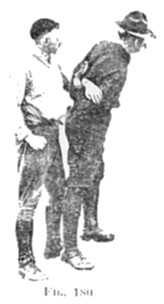
If you let the pressure relax, he may escape, but press his wrist upward
with your elbow, keep the full strain on his elbow and shoulder and he
cannot escape.
In your preliminary practice, be careful. Rather allow opponent to escape
than hurt him.
You can march two men prisoners by this method.
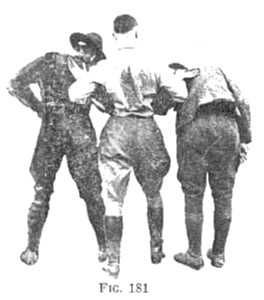
As they bend forward to escape, lower your body with them. Keep the
weight of your Stahara on their elbows.
This picture is taken at the moment both men are doing their utmost
to escape. It is not strength that prevents them from escaping. It is science.
HOW TO ESCAPE FROM A HAMMERLOCK
If your Assailant omits to maintain fullest pressure, if he fails to
keep you "on your toes" – bend forward letting your arm come straight and
bringing your left shoulder round towards your right.
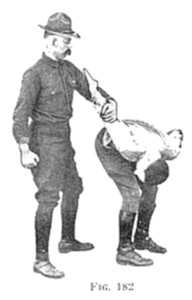
You can free your arm and if necessary attack opponent with your left
fist.
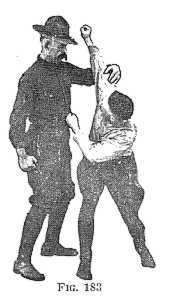
SWIFT METHOD OF MAKING AN ARREST
A man you wish to take prisoner is walking to meet and pass you unconscious
of any danger. (My right hand is held thus for purposes of instruction.
In reality you would conceal your intentions.)
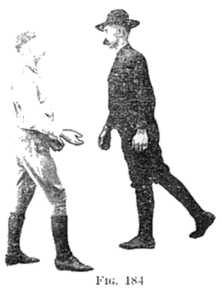
As you pass him, place the palm of your right hand on the back of his
left, your thumb around the little finger edge of his hand. Your left hand
is placed inside and above his elbow.
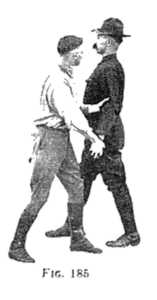
Wheel round quickly facing the way he is going, and continue walking
with him. Your left arm merely pulls his elbow inside your right forearm.
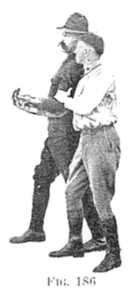
Raise your right forearm, bringing him into position of Figure 187.
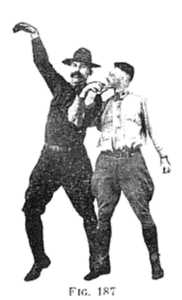
Exert pressure on the little finger side on the back of his hand, pressing
it towards your left and downwards. This will bring him onto his toes,
unbalanced,
and you can march him where you will.
(If necessary, use both hands to twist his left hand until you learn
the correct angle, when one hand will be ample.)
VERBUM SAP: A WORD TO THE WISE IS SUFFICIENT
Practice these tricks all you can. Practice them with as many different
people as you can. But do not go around looking for unsuspecting victims
to try them out on.
There is a time and place for everything. So do not make yourself a
nuisance by selfishly doing a "stunt" on a friend at an inopportune time
or place. You may hurt his feelings, or through your own inexpertness you
may injure him.
The better plan would be to interest him in your work and to have a
regular practice with him, thereby benefiting him as well as yourself.
Lesson 39. The "Funny-bone Come-along."
Lesson 40. To eject a troublesome visitor.
Lesson 41. Turning the tables on a "Hand-squeezer."
Lesson 42. How to make a man let go.
| |
Name of Partner |
Date Commenced |
Lesson 39 |
Lesson 40 |
Lesson 41 |
Lesson 42 |
| 1. |
|
|
|
|
|
|
| 2. |
|
|
|
|
|
|
| 3. |
|
|
|
|
|
|
| 4. |
|
|
|
|
|
|
| 5. |
|
|
|
|
|
|
| 6. |
|
|
|
|
|
|
| 7. |
|
|
|
|
|
|
| 8. |
|
|
|
|
|
|
| 9. |
|
|
|
|
|
|
| 10. |
|
|
|
|
|
|
Lesson 43. Finger hold and Escape.
Lesson 44. A simple Wrist-break.
Lesson 45. An amusing Neck-hold.
| |
Name of Partner |
Date Commenced |
Lesson 43 |
Lesson 44 |
Lesson 45 |
| 1. |
|
|
|
|
|
| 2. |
|
|
|
|
|
| 3. |
|
|
|
|
|
| 4. |
|
|
|
|
|
| 5. |
|
|
|
|
|
| 6. |
|
|
|
|
|
| 7. |
|
|
|
|
|
| 8. |
|
|
|
|
|
| 9. |
|
|
|
|
|
| 10. |
|
|
|
|
|
Make a check mark against each trick each day you practice it.
THE JAPANESE POLICEMAN’S "COME-ALONG"
A trick known in this country by the above name (but not in Japan, where
I have never seen it used), is to seize opponent’s left wrist with your
left hand. Pass your right arm over his left arm. Bring your forearm under
his forearm, and clasp your left wrist with your right hand.

If you are more powerful than opponent, you can cause him considerable
pain and force him to come along. But if he is more powerful than you,
he will have no difficulty in withdrawing his arm from your hold and in
striking you in the face if he so desires.
A variation of this trick, wherein you grasp his left palm instead of
his left wrist, is a little better.
ANOTHER METHOD
By passing your forearm behind his elbow with the palm of his hand up,
you can break his elbow by jerking his arm down. Unless you go the length
of breaking his arm, however, a stronger man can escape from this hold.
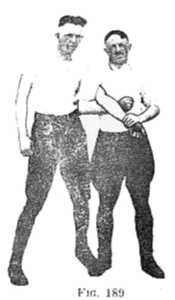
You cannot control your prisoner in practice, for by the time you begin
to cause him pain, you have almost wrenched his elbow ligaments.
THE "FUNNY-BONE COME-ALONG" – AN INSIDE WRINKLE
There is a sensitive spot two inches above the elbow on the inside of
the arm. (Press the end of your thumb into your own arm and discover its
exact location.) The secret of this trick is to press the sharp edge of
your wrist-bone against this spot.
To expose this spot to wrist-bone pressure, his thumb should
be uppermost, not his palm.
Hold tightly with your upper arm and press his hand straight down, his
little finger being underneath. Force opponent to his toes and lead him
around the room.
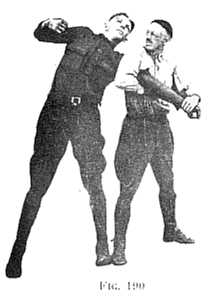
THE WRONG WAY
This position is wrong. My opponent has been allowed to remain on
balance. My position is unstable. The Stahara has no strength.
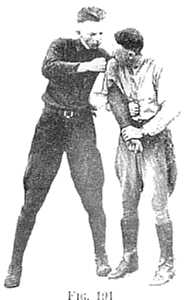
Compare with Figure 190, where the posture of the body reinforces the
arm. Unbalance opponent while taking hold and thus prevent his striking
you.
TO EJECT A TROUBLESOME VISITOR
An amusing recipe for ejecting an unwelcome visitor from your home,
is to shake hands with him, in an apparently friendly fashion. Then pull
his hand toward your right. Step towards him with your left foot. Pass
your left arm beneath his right arm until your shoulder is right under
his armpit. Then pull his hand forward toward your right.
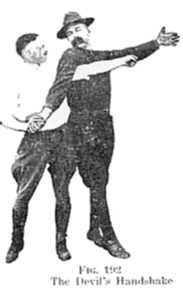
The pain in his shoulder will bring him to his tiptoes, and will enable
you, firmly but gently, to walk him out the front door.
Should anyone try this hold on you, quietly bring your left hand on
top of his wrist, and simply push his hand down, thus instantly freeing
yourself.

If you wish to turn the tables on the humorist who is making you the
subject of his experiments, place your hand on his wrist, and pull it gently
back, pressing your chest against his elbow.
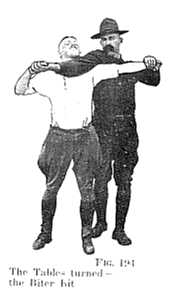
The signal of defeat in this instance cannot be given by the hands as
they are both engaged. Stamp quickly on the floor with the foot twice and
your opponent will instantly release you.
ANOTHER "COME-ALONG"
Instead of passing your upper arm beneath opponent’s armpit, as in Figure
192, just pass your forearm, and grasp he clothing on his right chest with
your left hand.
Press his arm down exactly as in Figure 192 and make him submit, or
lead him captive by the pain in his upper arm.
This is not a very reliable method of taking prisoners and is simply
given to increase your general experience in such matters.
TURNING THE TABLES ON A "HAND-SQUEEZER"
Some men persist in trying to grind your hand into a pulp to show off
their strength.
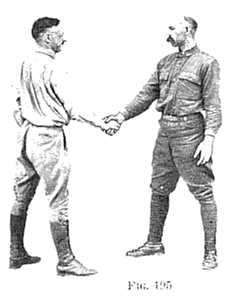
When you meet such a gentleman, pull his hand straight out sideways.
Step past his right foot with your right foot, so that your head passes
beneath his armpit. (Let me warn you never to try this till you have practiced
it with ten different opponents.)
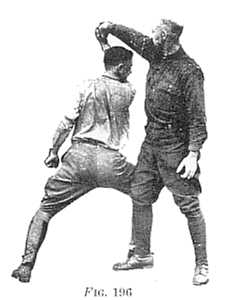
Turn and look towards your left. Continue pulling his arm in the same
direction, straight out from his side, so that you unbalance him
in that direction. By this time you have passed completely under his arm.

Raise your left arm and bring your armpit over his upper arm. Do not
twist his arm but pull the little finger side of his hand straight to your
face.
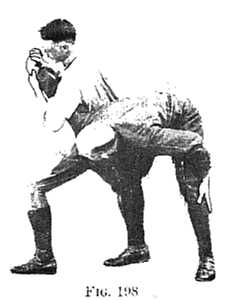
With your upper arm, hold his arm tightly, and with the weight of the
body, press his upper arm down until he gives the signal of defeat. Try
it very slowly at first.
HOW TO MAKE A MAN LET GO
Your opponent is holding on to something and you cannot pull him off.

Place the ends of your thumbs behind the lobes of his ears and against
his jawbone.
Press straight upward. Bring him onto his toes, and he will gladly accompany
you.
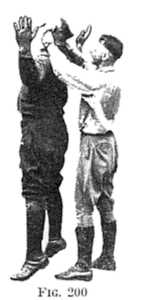
Be careful at first to avoid injury, and experiment a little until you
find the sensitive spot.
FINGER HOLD
With your right hand, take the fingers of opponent’s left hand so that
the backs of his fingers lie in your palm. Grasp them with your fingers
and thumb.

Raise his hand straight up, till it is over your head, and bend his
fingers back, at right angles to his hand.
This will bring him onto his toes and you can then march him around.
A SIMPLE BREAK FOR ABOVE HOLD
Fold your thumb over your palm until the tip of your thumb touches your
little finger.

Lower your wrist and draw your elbows to your side. Bunch the tips of
your fingers together and you will have no difficulty in withdrawing them
with an upward movement from his grasp.
A SIMPLE WRIST-BREAK
Assailant pushes you with his right hand flat on your chest.

Bring the palm of your right hand onto the back of his left hand, and
your left hand onto the back of your right. Hold his palm tightly against
your chest.
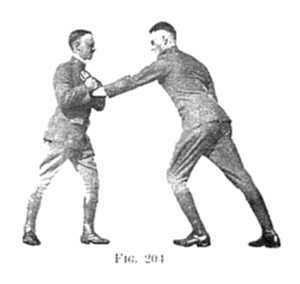
Bend forward, and the pain in his wrist will bring him to his knees.
Make him give the signal of defeat.
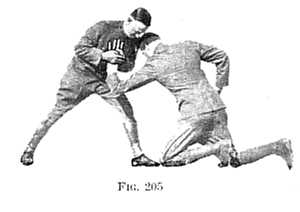
The only strength required is to keep his palm (especially that
part close to his wrist, the heel of his hand) pressed tightly against
your chest. He provides the motive power, as the harder he pushes,
the worse for his wrist.
Do this very slowly at first, otherwise you may injure his wrist, or
you may bring him down too hard on his knee.
The trick can only be done when a man is actually exerting strength
against your chest. It is useless to try and pull his hand onto your chest,
and if he tries to pull his hand away, you have no chance of getting it.
If, however, he is determined to shove you back by his greater strength,
that is where you can turn his greater strength against him by getting
his wrist in a trick. A chance to do this will seldom occur, but when it
does, this trick will come handy.
It gives you further experience in using the opponent’s strength against
him, and each added experience makes you better able to apply the principle
in all other tricks.
AN AMUSING NECK HOLD
Clench your left fist and place the sharp second knuckle-joint of the
first finger in the middle of the large sterno-mastoid muscle on the side
of opponent’s neck.
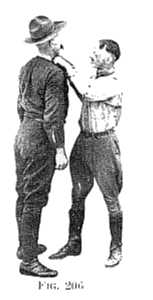
With the right hand, clasp the little-finger side of your left hand
in such a way that you do not interfere with your knuckle-joint pressing
his neck.
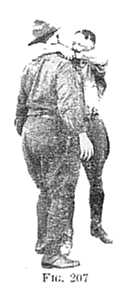
Place the side of your face against his cheek, and with the strength
of both arms, press the sharp knuckle into his neck.
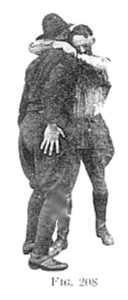
There is a peculiarly sensitive spot here. Let your first experiment
be gentle. Opponent gives signal of defeat by slapping his thigh.
Ladies might find this a useful means of persuading their husbands to
present them with a new hat. It can be taken with the speed of lightning
and once secured, opponent is helpless.
It is not recommended as a practical fighting trick, as it leaves you
open to a kick just before it is secured.
















































